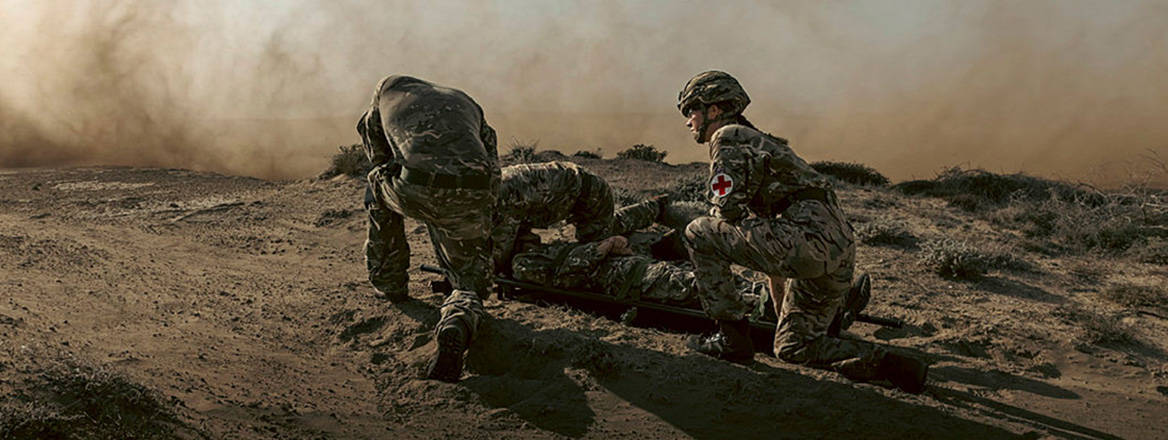Preparing for the Human Cost of War in the British Armed Forces
As the national conversation on preparing for war gathers pace, what can the UK learn from its own experiences and from the present conflict in Ukraine when it comes to dealing with the impact of mass casualties?
Recent months have seen an enhanced focus on the British military’s preparedness for war in a range of areas, including equipment, personnel, logistic and medical support. However, almost no attention has been paid to the human cost of war for members of the British Armed Forces and their families, much less to how the organisation – and indeed, wider society – will respond and cope.
This lack of focus is problematic for a number of reasons. On a practical level, it limits opportunities for learning, planning and coordination of resources. However, there is also a moral component; failures to provide care and support to both service members and their families in the event of loss of life and severe injury will have implications for morale, retention and recruitment, all of which could negatively affect operational effectiveness.
In addition, there has been limited reflection and learning from recent conflicts considering not just what worked well but what could be scalable in the event of mass fatalities. In fact, the UK lags behind the US, Canada and Israel on research in this area, and while organisational ‘forgetting’ is a well-established criticism of the military more generally, the failure to both remember and learn from past conflicts means that there may be missed opportunities to plan, prepare, coordinate and resource a response.
‘Taking Care of its Own’
The Joint Casualty and Compassionate Centre (JCCC) is the lead organisation for the UK’s Ministry of Defence (MoD) responsible for managing and coordinating the practical requirements following the death, injury or serious illness of a service person. However, each service has its own process for family liaison and support, relying on service members to volunteer or be directed to undertake the responsibility for casualty notification and family liaison.
While knowledge, understanding and practices in this area have seen significant progress, a full state-on-state conflict will likely yield an unprecedented number of fatalities, placing a strain on forensic services
These duties are executed in two separate roles: the Casualty Notification Officer (CNO) and the Visiting Officer (VO). While the CNO role is often concluded almost immediately upon notifying the family, the remit of the VO is vast and includes acting as the liaison between the MoD and the family, in addition to providing practical and emotional support in the immediate aftermath of the death, up to and including the Coroner’s inquest.
It goes without saying that the military ethos of ‘taking care of its own’ is admirable and frequently enables strong bonds to be established between the bereaved military family, their VO and the service member’s unit. Many bereaved families describe these relationships as a significant source of comfort, offering connection and access to support and information at a time of grief, anguish and overwhelm.
However, the level of commitment required both in terms of time and emotional resource on the part of the VO and the wider military is significant. This raises questions as to whether the organisation can successfully sustain this approach in the event of mass fatalities, and if so, at what cost to its overall effectiveness and capability. Put simply, the military will require every service member to turn their attention to the business of warfighting, leaving little time and energy to support bereaved families.
The Challenges of Wartime
There are a number of unique challenges associated with wartime losses. These include delays with identification and repatriation, both of which have the potential to compound the grief and anguish of a bereaved family. While knowledge, understanding and practices in this area have significantly progressed since the end of the Second World War, a more general state-on-state conflict will likely yield an unprecedented number of fatalities, placing a strain on forensic services. Perhaps more significantly, the traumatic circumstances of these deaths will present challenges for the process of disaster victim identification (DVI), particularly if they occur in enemy-occupied territory where retrieval and repatriation may have to wait until either a ceasefire or exchange agreement is in place.
The UK has much to learn – not just from countries like Ukraine, but by taking the opportunity to reflect on its experiences of responding to military fatalities over the past two decades
In recent years, the MoD has publicly demonstrated its commitment to both repatriating and individually honouring each of its service members who die on operations overseas, signalling both a historical shift in commemorative practices and garnering support for the armed forces. Indeed, the scenes from what is now Royal Wotton Bassett have become synonymous with public recognition of the sacrifice of the bereaved family and a means of honouring the life of the fallen service person. However, we must consider whether such traditions and commitments could be continued in the event of a state-on-state war, and how not doing so could impact bereaved military families, civil-military relations and overall support for the armed forces during a time of immense need.
A further challenge of wartime is the possibility that service members will become missing in action or be taken as Prisoners of War (PoW). The MoD’s current Joint Service Publication relating to the management of casualties and the deceased recognises this risk by highlighting the various ways in which these personnel may be categorised, emphasising the role of the JCCC in providing updates to the service member’s family, alongside the input offered by the VO. Yet current training for both the CNO and the VO roles focuses solely on understanding and meeting the practical and emotional support needs of the bereaved family, and fails to mention or account for the challenges of engaging with families of the missing or PoW. Such an oversight may have profound implications not only for the service member’s family, but also for those service members expected to fulfil these support roles with little or no understanding of how to respond to their specific needs.
Learning from Ukraine
We don’t need to look far to gain an insight into the human cost of war. Ukraine continues to endure daily losses which go beyond anything seen in Europe since the Second World War. The exact figures are rarely shared by Ukraine, and yet what has emerged are the country’s efforts – both collectively and individually – to honour and humanise those who have died. Examples of this include President Volodymyr Zelensky’s recent law guaranteeing military personnel the right to posthumous parenthood – an initiative which enables the biological material of fallen soldiers to be stored for three years after their death at the expense of the state, and if it is used to conceive a child, ensures that the fallen soldier will be legally recognised as the child’s parent. In response to the complexities of the recovery, retrieval and repatriation of those who have died, a network of volunteer ‘body collectors’ has been formed to search for and bring home fallen soldiers who have been left behind. Despite the high death toll, funerals with military honours continue to be conducted, even when the family and the military unit cannot be present. Indeed, many of the stories that have transpired since the start of Russia’s full-scale invasion in February 2022 emphasise both the human cost of war and the humanity of Ukraine’s response to such losses.
From a support perspective, the establishment of Ukraine’s Coordination Headquarters for the Treatment of Prisoners of War in March 2022 has developed practice in relation to both caring for, and providing information to, military families of the missing and PoW. In doing so, it has generated a body of knowledge and understanding of the specific needs of these families and how they might be addressed. Such insights will be invaluable to the British military, and should be used to underpin the development of policy and further training in this area.
Likewise, Ukraine is learning how to cope with mass military fatalities with limited resources, finding ways to stay connected and to ensure that bereaved military families have access to support – for example, the Tragedy Assistance Program for Survivors (TAPS). Founded in 1994 by army widow Bonnie Carroll to provide care and support for bereaved military families across the US, this organisation has been operational in Ukraine since Russia’s first invasion in 2014, recently launching a dedicated TAPS Resilience Centre that offers workshops and psychological support for bereaved Ukrainian military family members. While the military ethos of ‘taking care of its own’ is admirable, Ukraine is learning that it cannot do it alone, and is instead drawing on the expertise of the international community to bolster its efforts.
Now is the Time for Preparation
The UK has much to learn – not just from countries like Ukraine, but by taking the opportunity to reflect on its experiences of responding to military fatalities over the past two decades. This learning needs to extend beyond a review of the military’s current policy and process to seek input from bereaved families themselves, service members who have undertaken the CNO and VO roles, and academics and practitioners working in the field of trauma and mass fatalities. Given the unique set of challenges that war presents, a coordinated approach is critical to ensure that the potential human cost is accounted for, not just by the military but by society more widely.
The views expressed in this Commentary are the authors’, and do not represent those of RUSI or any other institution.
Have an idea for a Commentary you’d like to write for us? Send a short pitch to commentaries@rusi.org and we’ll get back to you if it fits into our research interests. Full guidelines for contributors can be found here.
WRITTEN BY
Dr Nicola Lester
Viktoriia Tsymbaliuk
- Jim McLeanMedia Relations Manager+44 (0)7917 373 069JimMc@rusi.org




